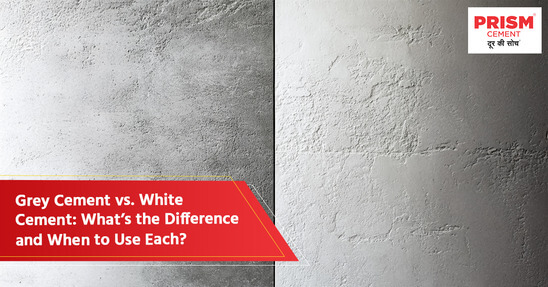
Introduction to Grey Cement and White Cement
Cement, a fundamental building material, comes in various types, each with its unique properties and applications. Two of the most commonly used types of cement are grey cement and white cement, both of which are essential components of construction. However, they differ significantly in terms of their appearance, composition and applications. Here, we discuss the difference between white cement and grey cement.
Grey cement is the most widely used type of cement. It is produced by heating a mixture of limestone, clay and other raw materials in a rotary kiln at extremely high temperatures. This process results in the formation of clinker, which is then ground into a fine powder. Grey cement's colour is derived from the iron oxide present in the raw materials.
White cement, on the other hand, is produced using carefully selected raw materials that are low in iron oxide content. This results in a lighter color and a higher degree of whiteness. The production process for white cement is similar to that of grey cement, with additional refining steps required to achieve its desired whiteness.
When selecting the right type of cement for your project, consider the following factors:
By understanding the key differences between grey cement and white cement, you can make informed decisions about which type is best suited for your specific project. Whether you're building a residential home or a commercial complex, choosing the right type of cement is essential for ensuring the strength, durability and aesthetic appeal of your structure.
Prism Cement offers a range of high-quality PPC variants tailored for roofing and roof slabs:
Experience the Prism difference in your next project and build with confidence using our superior PPC cement options.
Prism Cement a division of Prism Johnson Limited is one of India’s leading integrated Building Materials Company, with a wide range of products from cement, ready-mixed concrete, tiles and bath products.
Prism Johnson Limited is an IMS Certified Company (ISO 9001:2015, ISO 14001:2015, ISO 45001:2018,SA 8000:2014 & ISO 50001:2018). Quality assurance is an integral part of Prism Johnson Limited manufacturing philosophy. The strength and other characteristics are much higher than the BIS requirements. Excellent quality has placed Prism Cement in the premium price segment.
KNOW MORE305, Laxmi Niwas Apartments, Ameerpet,
Hyderabad - 500016, Andhra Pradesh
![]() Tel: +91-40-23400218
Tel: +91-40-23400218
![]() Fax: + 91-40-23402249
Fax: + 91-40-23402249
"Rahejas", Main Avenue, V.P. Road,
Santacruz (W), Mumbai - 400054,
Maharashtra
![]() Tel: +91-40-23400218
Tel: +91-40-23400218
![]() Fax: + 91-40-23402249
Fax: + 91-40-23402249